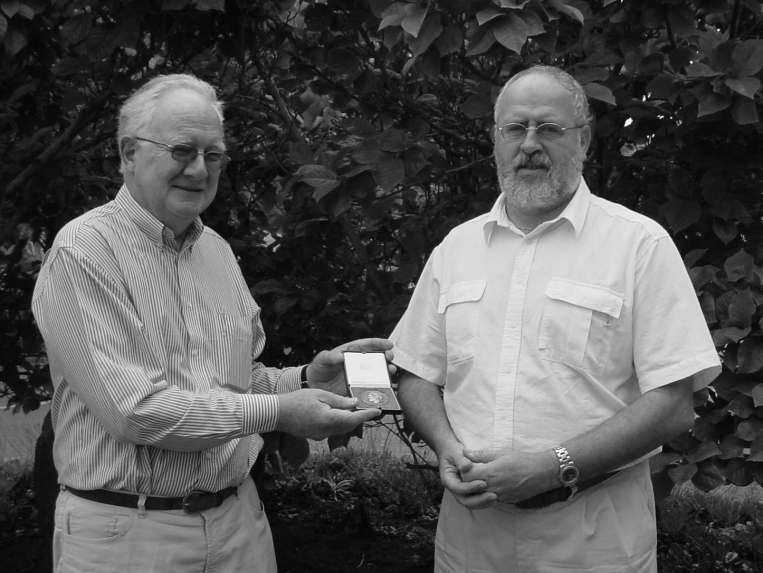Berto Monard was awarded the Society’s Gill Medal at a function held during the 2004 ASSA Symposium in Johannesburg.
Berto has become known as one of the most accomplished amateur astronomers in the world and is one of the most active in South Africa. He has recently distinguished himself by being the first amateur anywhere to detect a gamma-ray burst. He has also discovered many supernovae in nearby galaxies – seven this year alone.

Dr Ian S. Glass (left) presenting the Gill Medal to Berto Monard. The award was made at the 2004 ASSA Symposium in Johannesburg.
Berto started observing with a small telescope in 1990 and has produced more than 29,000 visual observations of variable stars for the AAVSO and the VSS of RASNZ. He has used modern techniques of electronic detection to go far beyond the capability of the unaided human eye. With the larger telescopes he has possessed since 1997, he has shown a great instinct for interesting targets: very old novae, faint novalike variables and stars that challenge the archetype for cataclysmic variables. He is one of the most productive members of the Centre for Backyard Astrophysics, a world-wide network which includes some of the most active amateur astronomers. He moved to a darker site east of Pretoria in 2001, where he built the Bronberg Observatory, equipped with a 12.5-inch telescope and a CCD system.
The circumstances of the GRB discovery are worth relating. Much of Monard’s work involves monitoring of cataclysmic variables, but possibly interesting transient events get priority. The gamma-ray burster GRB 030725 was found by the HETE-2 (High-Energy Transient Explorer – 2) satellite on 25 July 2003. Its coordinates were disseminated to astronomers worldwide, including the International High-Energy Network of the AAVSO, who notified Monard. Some seven hours after the event, at 20:45 UT, he made a series of unfiltered CCD images of the source region, which was at a declination of –50°. In the following minutes he processed the images digitally and found something peculiar at the edge of the field of view, but slightly outside the 90% confidence error box. He immediately reported a possible discovery to AAVSO and by 22:00 UT he had a new series of images with the event in the field centre. Already the object showed signs of having faded from 18.8 to 19 mag. By 00:30 UT, it was at 19.6 mag. By 28 July it was found to be fainter than 21, but an observation on the Danish 1.5m telescope on La Silla was able to confirm it on July 29.
Berto was born in Belgium and moved to Pretoria in 1981, where he works at the National Metrology Laboratory of CSIR on photometry.
Source: mnassa, 63(11&12), 170.
